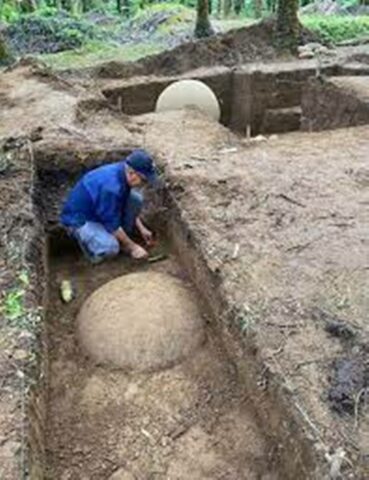A legend tells that when the conqueror of Peru, Francisco Pizarro, asked the great chiefs of the Inca empire how they determined the qualities of the shamans to give them validity and power, their answer was that the candidates for shamans had to be tested and trained in a great pilgrimage to the north, until reaching a magical place known as “the land of the spheres.”
The spheres
Whether or not that story is true, the truth is that the Diquis Valley increasingly confirms that it was a great city and a center of power based, precisely, on the stone spheres that these people made.
The National Museum researcher, Francisco Corrales, discovered with his team a new sphere buried in Finca 12 de Palmar Sur, only 5.7 meters from where another appeared in July of this year, both are placed in the corner of a ramp that It leads to a possible mound with a stone structure that was probably the base of a house.
Both spheres have a diameter of 1.2 meters, that is, they are basically the same size. The same situation described happened in other archaeological sites, such as the case of Finca 6, where the Museum of the Spheres is located.

That is, these two spheres were placed at the entrance to the land, at the end of a “corridor” or stone road that communicated the “entrance gate” with the home of a possible shaman or very important person within the hierarchy of that epoch.
Apparently these stones were symbols of power and announced the entry into the home of a person of great importance. One of those shaman-forming shamans that Pizarro allegedly mentioned?
Corrales and his team confirmed that “an excavation carried out in the surroundings of the sphere, allowed the discovery of an area with rows forming a cobblestone, a structure frequently used by pre-Columbian ancestors for roads and bases of houses.”
As the spheres were moved by banana plantations and previously by Costa Rican peasants, unfortunately the location of most of them is not known, but archaeological discoveries make it possible to think that this entire area was a great city inhabited by hierarchs whose power was symbolized by the use of the stone spheres at the entrance of their cosmo-conical ranches.
Gold and bridge
But also do not forget that this is an area where gold was also in common use, many of the rescued archaeological artifacts found in the pre-Columbian gold collection of the Central Bank Museums, comes from this area. The largest piece, in fact, was stolen from Violines Island, adjacent to the mouth of the Sierpe River.
Even today, in Corcovado National Park, “coligalleros” try to obtain gold from rivers illegally. Spheres, gold, favorable geography, and available natural resources formed a center of power.
As is known, Costa Rica is the natural border between what are now known as Mesoamerican cultures and the intermediate area -which includes the entire country, except the Chorotega region-. Between Panama, Costa Rica and some areas of Colombia the intermediate area is distributed, a region where there was influence of cultures from the two great regions: Mesoamerica and South America (Andes and Amazonia).
Based on the above, it is clear to us that the Diquis Valley was a natural bridge (the rest of the territory is mountainous and difficult to travel) between those who migrated from south to north and vice versa.
As reported by the National Museum, “the discovery of these spheres and their context will allow an updated knowledge of the settlement and the role that this could have within the ancient community that inhabited that place, as well as its relationship with other nearby settlements of the Diquís delta.”
Bridge of a pilgrimage?
Another interesting issue to be resolved is whether the Diquis delta (or Diquis Valley) could be a preamble to the pilgrimage to what is now known as the Guayabo Monument, a site with mounds, causeways and even an aqueduct that still works where, according to anthropologists, it is there might be a pilgrimage or spiritual center.
The entrance roads to the archaeological site come from several kilometers before, from the vicinity of Turrialba, many of those destroyed roads of about 3 to 5 meters wide pass under or near current houses.
The proximity to the Turrialba volcano, of course, also suggests that Guayabo could be a spiritual center where even some offering was charged to enter, the site has toll zones where only one person could pass per shift. In addition, tombs with gold objects and other materials of great economic value were found. Would this be the end point of that ancestral “pilgrimage” that came from the Inca territories?
The capital city
Of course, they are only assumptions that have not been proven by scientists. However, archaeologists make it clear that the Diquis was certainly a necessary transit bridge and a city with spaces of power that the spheres symbolized.Possibly we are talking about the capital city and the most important of all these territories at that time.
“These types of findings are very important to better understand the societies that inhabited the Diquís delta and that manufactured the stone spheres,” explained Corrales.We will then see what else is discovered, in addition to confirming the traditional order in these settlements.

